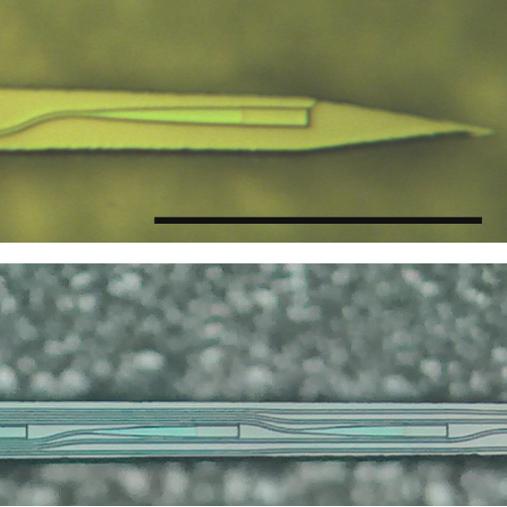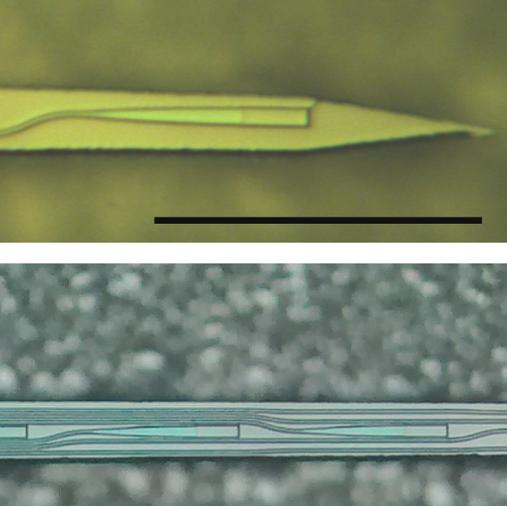
Credit: The authors: doi:10.1117/1.NPh.4.1.011002
BELLINGHAM, Washington, USA, and CARDIFF, UK — The ability to stimulate neural circuits with very high precision light to control cells — optogenetics — is key to exciting advances in the study and mapping of the living brain. In the current state of the art, spatially patterned light projected via free-space optics stimulates small, transparent organisms and excites neurons within superficial layers of the cortex.
However, light scattering and absorption in neural tissue cause light penetration to be extremely short, making it impossible to employ free-space optical methods to probe brain regions deeper than about 2 mm.
In "Patterned photostimulation via visible-wavelength photonic probes for deep brain optogenetics," published today by SPIE, the international society for optics and photonics, in the journal Neurophotonics, principal author Eran Segev of professor Michael Roukes' group at Caltech, along with coauthors from Caltech, Baylor College of Medicine, and Stanford University, describe a solution. The article is available via open access.
Their approach combines nanophotonics and microelectromechanical systems (MEMS) in an implantable, ultra-narrow, silicon-based photonic probe to deliver light deep within brain tissues. This minimally invasive technique avoids major tissue displacement during implantation.
Using techniques of optogenetics, a protein in the brain serves as a sensory photoreceptor and can be controlled by specific wavelengths of light. These combined techniques provide a new approach to stimulation of brain circuits with remarkable resolution, enabling observation and control of individual neurons.
These breakthroughs present widespread and promising applications for the neuroscience and neuromedical research communities. From characterizing the role of specific neurons and identifying neural circuits responsible for behavior to enabling new methods of operant conditioning through reward-induced circuit activations, optogenetics has become a new path for neuroscientists seeking advances in research capabilities.
The article appears in a special section in Neurophotonics, Brain Mapping and Therapeutics, with Shouleh Nikzad, Jet Propulsion Laboratory, Caltech, serving as senior guest editor. The special section is part of an SPIE partnership with the Society for Brain Mapping and Therapeutics (SBMT), serving as a multidisciplinary approach for using advanced technology to solve neurological disorders and disease and to understand neuroscience. The effort was initiated during Nikzad's term as SBMT president in 2015.
###
David Boas of Massachusetts General Hospital, Harvard Medical School, is the editor-in-chief of Neurophotonics. Launched in 2014, Neurophotonics is published digitally in the SPIE Digital Library and in print. The journal covers advances in optical technology applicable to the study of the brain and their impact on basic and clinical neuroscience applications.
The SPIE Digital Library contains more than 458,000 articles from SPIE journals, proceedings, and books, with approximately 18,000 new research papers added each year. Abstracts are freely searchable, and a number of journal articles are published with open access.
About SPIE
SPIE, the international society for optics and photonics, is an educational not-for-profit organization founded in 1955 to advance light-based science, engineering and technology. The Society serves nearly 264,000 constituents from approximately 166 countries, offering conferences and their published proceedings, continuing education, books, journals, and the SPIE Digital Library. In 2016, SPIE provided $4 million in support of education and outreach programs. http://www.spie.org
Media Contact
Amy Nel
[email protected]
360-685-5478
@SPIEtweets
http://spie.org/
############
Story Source: Materials provided by Scienmag





